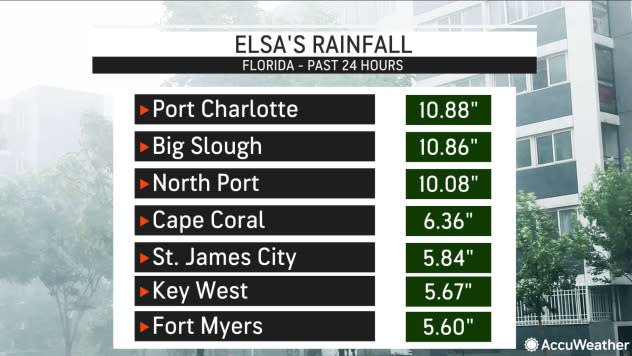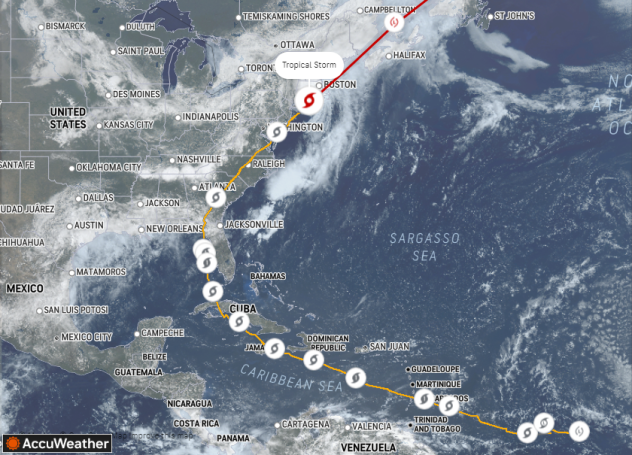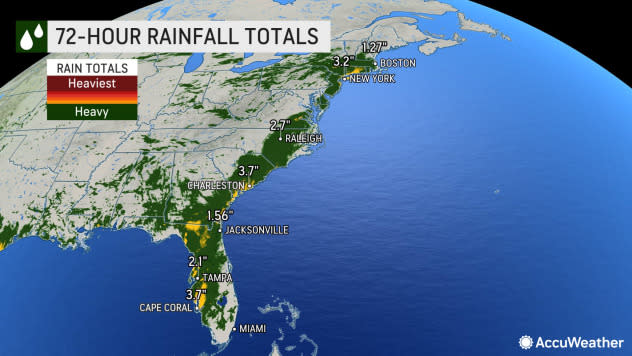Deadly Elsa completes trek from Caribbean to Canada
Elsa was no fairytale.
The first hurricane of the 2021 Atlantic Hurricane Season left a trail of destruction across the Caribbean, killing three people as it swept through with breakneck speed. The storm then made its way to Cuba, where it caused mudslides, and Florida, where it made landfall in Taylor County as a Tropical Storm on Wednesday, July 7.
 |
Elsa tracked from the Caribbean through the East Coast and was heading toward Canada as a Tropical Rainstorm on July 9 at 3:00 p.m. EDT. |
The storm killed one person in Florida while delivering high winds and heavy rain to the western part of the state. The storm then raced up the East Coast of the United States, causing more of the same effects. Wind gusts on the New Jersey coastline were nearly as powerful as when the storm made landfall. Tornadoes were reported from Florida to Virginia.
At 2:00 p.m. EDT on Friday, July 9, the National Hurricane Center downgraded Elsa to a "post-tropical system," which AccuWeather refers to as a Tropical Rainstorm.
Tracking up the coast, the storm had behaved like a nor'easter Thursday night into Friday, bringing high winds and heavy rain. Wind gusts early Friday morning on the mid-Atlantic coast rivaled those in Florida, with Harvey Cedars, New Jersey, gusting to 75 mph.
 |
Tropical Storm Elsa caused flooding and spawned tornadoes as it sped through Georgia and the Carolinas on Thursday, causing flooding and spawning tornadoes near the coast. AccuWeather National Reporter Bill Wadell described the tornado warnings as coming in "fast and furious" overnight in Charleston, South Carolina, where he captured video of people trudging through floodwaters downtown.
More than seven inches of rain fell in parts of coastal Georgia and South Carolina. By Thursday evening, another dozen tornado warnings had been issued for North Carolina into Virginia, with at least one twister confirmed in the town of Fairfield and another in Suffolk, Virginia. Dozens of hail and wind reports were noted up the coast as Elsa trekked northward.
 |
Rainfall Wednesday night into Thursday morning July 8, 2021 from Tropical Storm Elsa. |
As Elsa headed up the East Coast, the storm carried heavy flooding and forced power outages for thousands. In Georgia, another 10 were injured and taken to hospitals by ambulance after a possible tornado struck in Camden County amid Elsa's rampage northward.
More than 38,000 homes and businesses were in the dark across South Carolina, Wadell reported early Thursday. There were multiple tornado warnings in the Charleston area, as sirens blared throughout.
By Thursday evening, over 60,000 customers were without power from Virginia up the coast to New York, according to PowerOutage.US. Early Friday morning, that number fell to 20,000 at Elsa continued to move northward.
The storm system that couldn't decide if it wanted to be a hurricane or a tropical storm finally made landfall on Wednesday morning, crashing into Taylor County, Florida around 11 a.m. EDT. It was officially a tropical storm as it moved onshore.
 |
Like its cinematic counterpart, the storm's plot featured multiple climactic moments of action-packed strengthening but, ultimately, ended in many areas along Florida's Gulf Coast being largely spared from destruction. But not all spots of the state were spared from tragedy.
Elsa turned deadly in the U.S. on Wednesday evening, claiming one life after strong wind gusts sent a tree toppling onto a pair of cars in Jacksonville. Wind gusts of up to 50 mph were reported by the National Weather Service in the city around the time of the tragedy, which occurred amid heavy rains.
"Now is a time to remember ... that weather is unpredictable," Jacksonville Mayor Lenny Curry said during a news conference Wednesday, according to The Associated Press. "This is really early in the (hurricane) season. We're just outside of the July 4th holiday, we've had our first storm and, unfortunately, we've had a fatality."
Farther south, however, "fortunate" was the term used by Tampa Mayor Jane Castor on Twitter Wednesday morning as the city awoke to minimal damage and flooding.
"Fortunately, for us, we didn't see the storm surge that was predicted - 2 to 5 feet," she said in a posted video. "So that is a great thing for Tampa Bay, we haven't had the extensive flooding. We have some down trees and power out in certain places."
Meanwhile in Cedar Key, there was nothing fantastical about Elsa's impacts. Its forceful 65-mph maximum sustained winds at landfall hurled debris and triggered flooding throughout the Florida Gulf Coast.
The Tampa Bay area continued its seemingly mystical ability to avoid direct hurricane strikes. With a Muhammad Ali-like ability to dodge storms, the area again sidestepped a direct tropical punch as Elsa skirted along the side of the Sunshine State, paralleling the St. Petersburg area with little more than a wave hello from 65 miles away.
 |
A map showing 72-Hour Rainfall as of Friday morning. With the exception of heavy thunderstorms ahead of the storm, most of this heavy rain was from Tropical Storm Elsa. |
The state as a whole dodged the worst-case scenarios, particularly with regard to power outages and storm surge. As of 12:15 p.m. Wednesday, at least 20,000 state residents were dealing with outages, according to PowerOutage.us, as crews hurried to restore power in already-struck areas of the state, such as Key West.
Southeast of Key West, water rescues from a crew of Good Samaritans and the U.S. Coast Guard were required to save the lives of 13 people on Tuesday after a cargo vessel carrying 22 individuals capsized.
 |
A man treads water and awaits rescue crews approximately 32 miles southeast of Key West, Fla., on Tuesday, July 6, 2021. The U.S. Coast Guard and a good Samaritan rescued 13 people after their boat capsized off of Key West as Tropical Storm Elsa approached. (U.S. Coast Guard via AP) |
The Coast Guard said the individuals had left Cuba and that the other nine members were missing. According to The AP, the Coast Guard was first notified of the emergency by the Good Samaritan crew from a Western Carmen motor vessel around 1:30 p.m. Tuesday.
CLICK HERE FOR THE FREE ACCUWEATHER APP
It was there, in the popular tourist spot Key West, that AccuWeather National Reporter Bill Wadell spoke with vacationers and residents about what they were expecting from the season's first visit to Florida.
 |
Rough surf captured in Key West, Florida, on Tuesday, July 6, 2021. (AccuWeather/Bill Wadell) |
Vincent Rurro, a Key West resident of 10 years, told Wadell that he's learned to never take a storm lightly. Rurro and his wife live on the water full-time in a floating home they call the "turtle nest."
After a decade-plus of living in the state and dealing with storms such as Hurricane Irma, which totaled their sailboat in 2017, and Hurricane Charley in 2004, the couple said they know to look at more than just the hurricane cone.
"We don't think ‘oh we're not in the cone,'" he said. "I was in Hurricane Charley, in Punta Gorda, and originally we weren't in the cone and then all of a sudden it made a turn up into Charlotte Harbor and went directly over our house. Our community was demolished."
 |
At the time, Rurro said he was throwing a "hurricane party" with his neighbors and taking the storm lightly. He said they would never do that again.
"No more hurricane parties, we don't even say the word hurricane, we say ‘h-word,'" Rurro declared.
But his life on the water will take a lot more than a few more hurricanes to send him packing from Florida, Rurro told Wadell.
No matter how rough the storm, however, Vurro told Wadell that nothing could ever convince them to move off the water, even as Elsa was forecast to give them a troublesome night on Tuesday.
"The struggle is real," he said of the full-time boat life. "We live in paradise and this is the price you have to pay."
Elsa made its way to Florida following a deadly strike on the Caribbean. In the Dominican Republic, Elsa was responsible for the separate deaths of a 15-year-old boy and a 75-year-old woman after strong winds toppled the walls of houses in Baoruco Province.
Following its destructive visit to Cuba, where heavy rain triggered mudslides and nearly 200,000 were forced to evacuate, Elsa worked its way toward the United States.
But not before throwing a few curveballs.
 |
After departing Cuba late Monday night, the storm maintained tropical storm strength through early Tuesday, lashing the Florida Keys with intense rain and 65-mph winds. And hours later, after giving consistent hints that it would intensify, Elsa reclaimed hurricane force as is tracked northward, parallel to Florida's Gulf Coast.
Around 8 p.m. Tuesday night, the National Hurricane Center confirmed that maximum sustained winds from Elsa were back up to 75 mph, clearing the threshold of a Category 1 hurricane and setting the stage for a night of flooding.
Although the system's maximum sustained wind speeds weakened back below the hurricane strength threshold about six hours later, torrential rainfall triggered flash flooding in some communities. In areas such as North Port, Florida, located north of Fort Myers, residents awoke on Wednesday to extensive street flooding, as around 10 inches of rain fell in the area over a 24-hour span, according to AccuWeather National Reporter Kim Leoffler.
It was along the areas of southwest Florida, stretching from Naples to Tampa, where Elsa roared as an offshore hurricane before weakening back to a tropical storm.
Those same areas picked up some of the most extensive totals of rainfall from the storm, including three areas - Port Charlotte, Big Slough and North Port - that topped 10 inches.
 |
A list of the highest rainfall amounts reported from Elsa as of 10 a.m. July 7, 2021. (AccuWeather) |
Damage was reported near Jacksonville, Florida, and Kings Bay Base, Georgia, late Wednesday afternoon after two 'radar confirmed tornadoes' shredded trees and damaged homes. The Camden County EMA requested Wednesday night for people who live in the damaged area to shelter in place until the area is deemed safe.
Keep checking back on AccuWeather.com and stay tuned to the AccuWeather Network on DirecTV, Frontier, Spectrum, FuboTV, Philo, and Verizon Fios.













